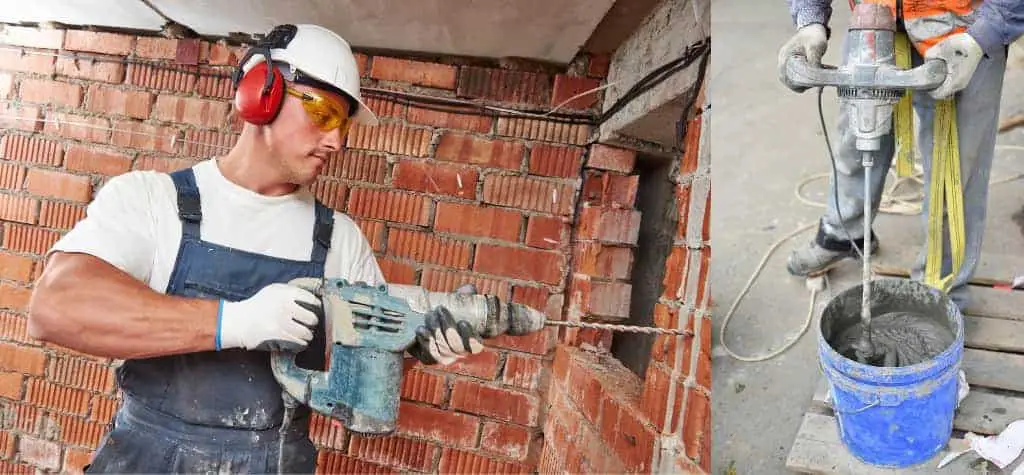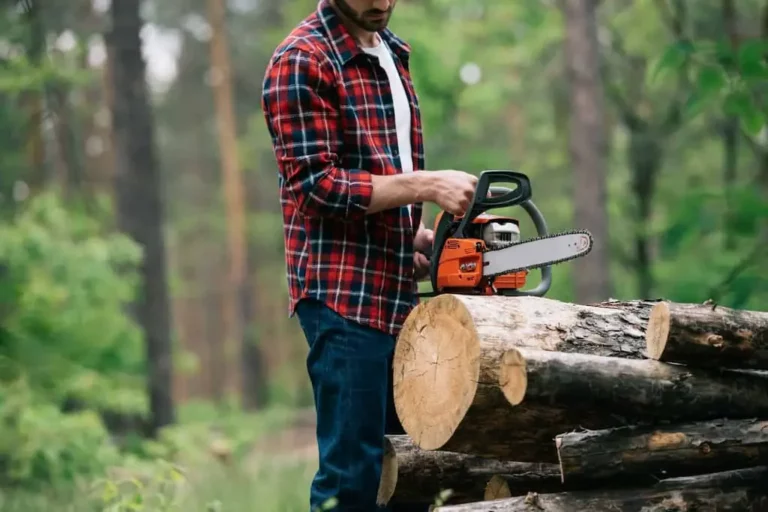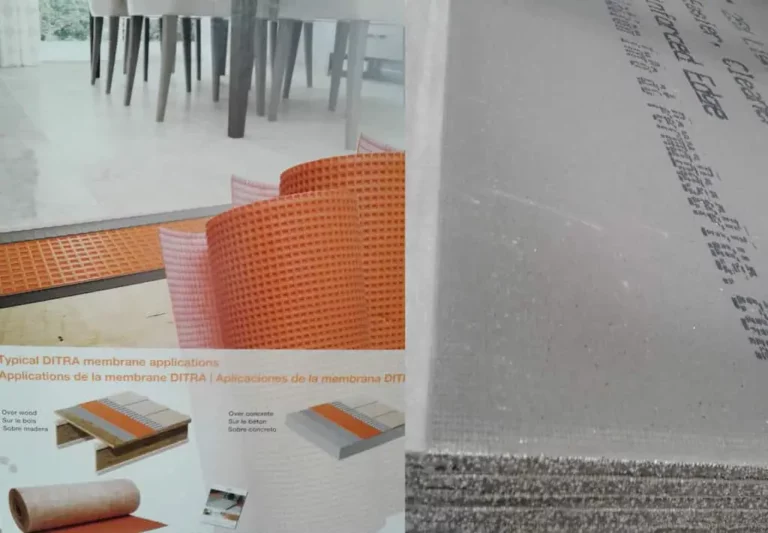Can You Mix Mortar With a Hammer Drill?

Mortar is a paste of sand and cement used to hold together bricks and stones. When mixing mortar, it is crucial to have each batch identical for one project to avoid expansion and cracking. With that in mind, you might be wondering if you can use a hammer drill to speed the process up.
You can mix mortar with a hammer drill, but spade handle mud mixers are the better tools for the job. Hammer drills are capable of mixing small amounts of liquid but are not designed for continuous, heavy mixing. You could also use a slotted drive shaft rotary hammer, but these are more expensive.
Many different tools can mix mortar, and some are better than others. Read on to learn more about mixing mortar with varying types of drills and figure out which one is right for you.
Using a Drill to Mix Mortar
Generally, hammer drills require too much applied force to be useful for mortar mixing as downward pressure is necessary to get the hammering action on these drills. This extra work makes them inefficient and tiring to use for mixing mortar.
As a general rule, if it spins, it will mix. However, it’s still important that the drill you’re using has the proper specifications. Standard drills can mix mortar as long as the drill has the correct specifications and the right attachments. These drills are the better option if you’re on a budget or if you already have a standard drill lying around.
If you’re going all-in on a drill, don’t skimp on the cost. Choose a highly-rated drill with a suitable mixture attachment, and you’ll have a drill that will last you for a long time and several different projects.
I have done a research into the best mixer I could find. Two are rated 4.5 stars on Amazon with great customer reviews. Here are the links to the Amazon customer review pages so that you can see for yourself what customers have to say:
DEWALT Electric Drill, Spade Handle, 1/2-Inch, 9-Amp
VIVOHOME 110V 1600W Electric Handheld Paint Cement Mortar Mixer Machine with 7 Adjustable Speed
Different Drills for Different Jobs
While not the ideal tool for the job, slotted drive shaft (SDS) rotary hammers are better than standard hammer drills for mixing mortar. If you want a drill that can take on more jobs than just mortar mixing, an SDS rotary hammer could be what you need.
They provide the rotational torque needed to mix heavy mediums like mortar. They can also drill holes in and chisel concrete and metal. SDS rotary hammers are best if you’re dealing with a variety of projects.
However, if you only need a tool to mix mortar alone, purchasing an SDS rotary hammer isn’t cost-effective, especially if you’re on a budget. There are more specialized tools for the job, and they’re less expensive than the heavy-duty rotary hammers. Even a standard drill with a paddle attachment will serve you well for a one-time mortar mixing job.
Keep in mind that the names “rotary hammer” and “hammer drill” are often used interchangeably, but they’re not the same tool. A rotary hammer is made for heavy-duty jobs, whereas hammer drills are less advanced power tools made for jobs like drilling or chiseling in brick, wood, or metal.
If you’re looking for a tool specifically designed for mixing mortar, a spade handle mud mixer is the best option. I recommend the Makita ½ Inch Spade Handle Drill. These tools have a spade handle and an auxiliary handle, making them easier to hold during your mud mixing. Like most drills, however, spade handle drills can be used for other jobs as well.
What Specs Should a Drill Have for Mixing Mortar?
When choosing a drill for mixing mortar, it needs to have certain specifications, including:
- Variable speed control
- Low RPM
- High torque capacity
Low RPM is necessary to avoid burning up your drill as it mixes. The variable speed option is needed because if the drill rotates too quickly; you run the risk of making a huge mess. You’ll end up with more mortar on the floor and walls than in the bucket. However, variable speed drills with extremely high maximum speeds might not be best for the job either. I highly recommend specialty tools for specific jobs.
For mixing mortar, the force behind the drill matters most. Just because your drill has a high BPM doesn’t mean that it will perform the job properly, especially if there’s not enough force. Your drill needs to pack a punch which is why torque is so important.
What Drill Attachments Are Best for Mixing Mortar?
For mortar mixing, you’ll need the proper attachment. The best attachments for mixing are paddle attachments which are available for a variety of different drills. For example, an SDS rotary hammer with a ½ inch (1.27 cm) chuck can hold a paddle mixer, and the size makes them suitable for heavy-duty jobs. You could potentially burn out a ⅜ inch (1.91 cm) drill on mortar mixing.
Additionally, there are spiral mixers and ball mixers, both of which can do the same thing. However, paddle mixers are more versatile and can mix a variety of mediums.
Make sure that your paddle attachment suits the drill that you’re using. Never use accessories or attachments that aren’t designed for the tool that you’re handling. For compatibility requirements or questions, refer to your tool’s instruction manual or reach out to the manufacturer.
Can You Use a Drill To Mix Cement or Grout?
Yes, you can use a drill to mix cement or grout, but the same rules apply. The drill must have the correct specifications and attachments.
Using a standard drill and paddle attachment to mix cement or grout is a cost-effective way to combine your materials without having to invest in a specialty tool. As long as the drill has low RPMs, enough torque, and the proper mixing attachment, you should have no problems mixing cement or grout with a standard drill. However, these aren’t suitable for regular mixing, so bigger jobs will require specialty tools.
Again, be sure that you’re using attachments made for your specific drill to avoid ruining your power tools, or worse, causing injury.
Generally, it’s a better idea to purchase a specifically suited tool for the job if you can handle the cost. Using a specialty tool prevents the risk of burning up your other tools. Alternatively, you could visit your local hardware store and see if they offer tool rentals. Tool rentals are less expensive than purchasing the tool outright and will ensure that you’re getting the right tool for the job.
What Is the Secret to Mixing Mortar?
Consistency is critical when mixing mortar for your projects, so the water-cement ratio is crucial. The mortar should be thick enough so that it doesn’t drip off your attachment but falls off with a bit of shaking. Always read the packaging before getting started and follow the ratio instructions.
Use a five-gallon (18.93-liter) bucket to mix your mortar. Add ½ of the water first, and then turn on your drill so that the paddle starts spinning. As the paddle spins, add your dry material to the bucket. By adding water first, you reduce the amount of work that your tool has to do. Add the remainder of water until it reaches the right consistency. Don’t be afraid to mix in more water or more dry material to get the consistency right.
If your drill starts to get hot while mixing, turn it off immediately. You run the risk of burning up your tools if you allow them to get hot during the mixing process.
Conclusion
So, will hammer drills get the job done? Hammer drills utilize hammering-action to apply force, and they’re generally used for drilling concrete and masonry. Despite their ability to pound through hard materials, they’re usually not the best option for mixing mortar, as they require the user to exert more physical force.






